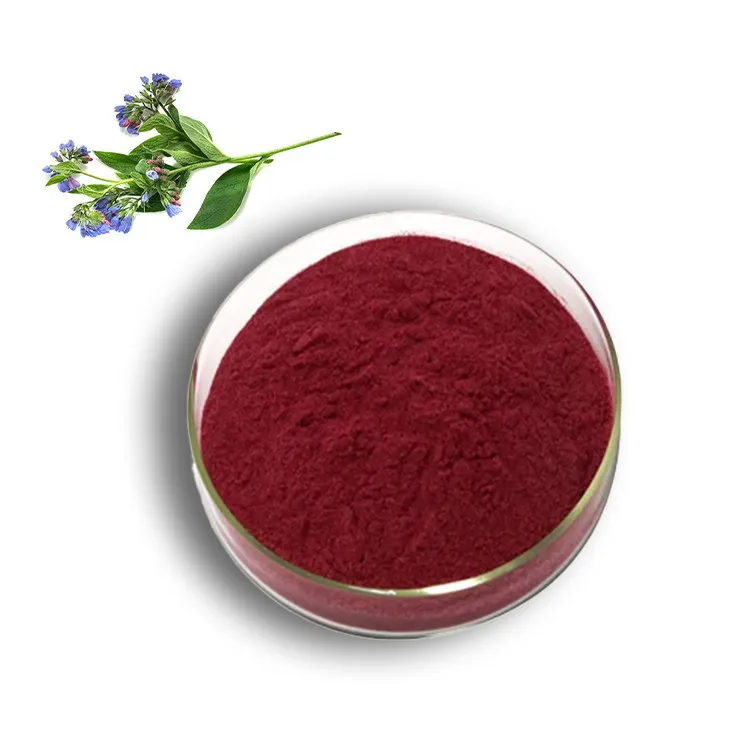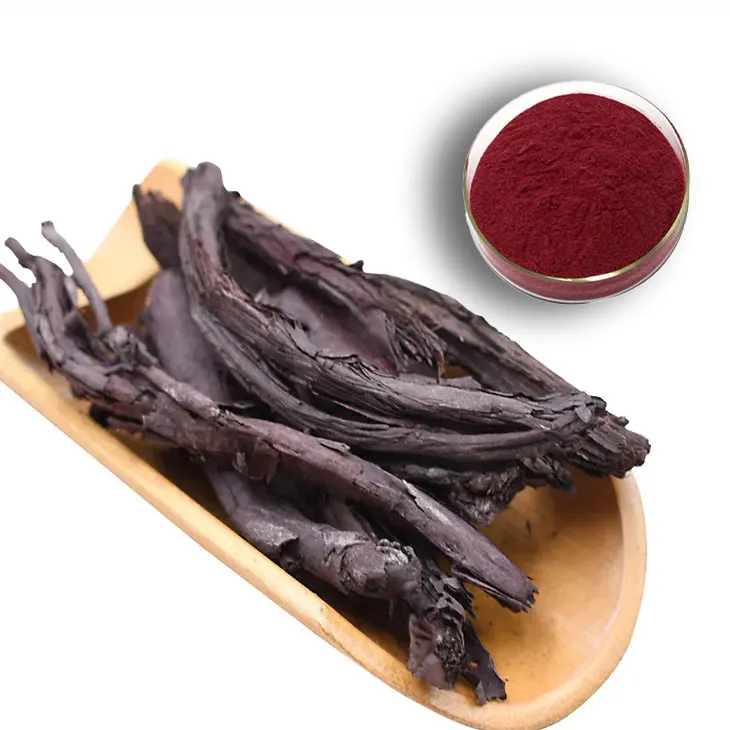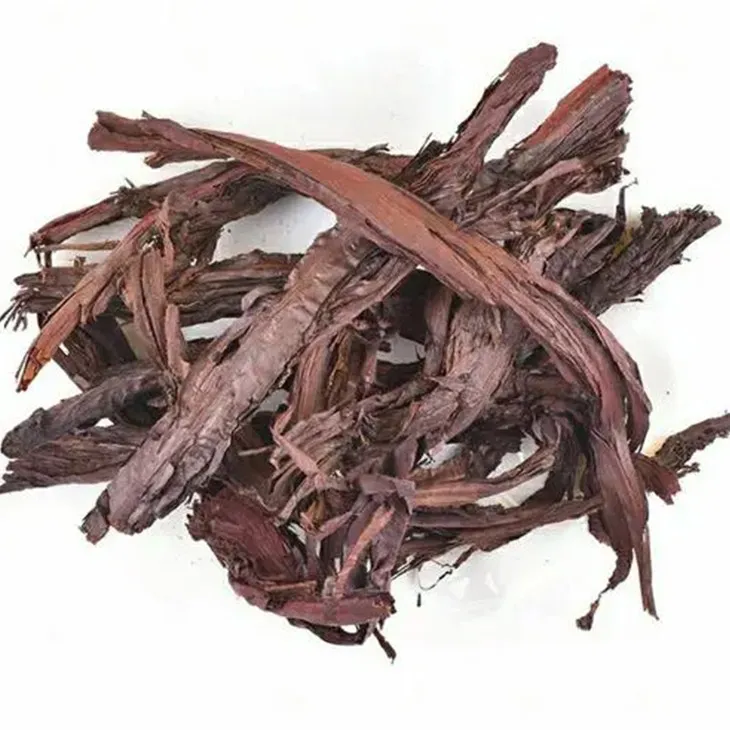- 0086-571-85302990
- sales@greenskybio.com
Shikonin manufacturers.
2024-11-29

Introduction to Shikonin Manufacturing
Shikonin manufacturers play a crucial role in the production and supply of this important substance. Shikonin is a compound that has attracted significant attention due to its diverse biological activities and its characteristic vivid color. The manufacturing process of shikonin is complex and requires a high level of expertise.

Raw Material Sourcing
Cultivation of Shikonin - Rich Plants
Manufacturers often start with the cultivation of plants that are rich in shikonin precursors. These plants need to be carefully grown in suitable environments. For example, the Lithospermum erythrorhizon plant is a well - known source of shikonin. Farmers or growers need to ensure proper soil conditions, sunlight exposure, and watering schedules to promote the growth of these plants. This is essential as the quality and quantity of shikonin that can be extracted later depend on the health and growth of these source plants.Collection of Wild Plants (if Applicable)
In some cases, manufacturers may also rely on the collection of wild plants that contain shikonin precursors. However, this must be done in a sustainable and legal manner. There are strict regulations regarding the collection of wild plants to protect the ecological balance. Manufacturers need to ensure that they have the necessary permits and follow ethical guidelines to avoid over - exploitation of natural resources.
Extraction Process
Traditional Extraction Methods
Traditional extraction methods for shikonin have been used for a long time. These usually involve processes such as solvent extraction. Solvents like ethanol or hexane are often used to extract shikonin from the plant material. The plant material is first dried and ground into a fine powder. Then, it is soaked in the solvent for a certain period of time. After that, the solvent is evaporated to obtain the crude shikonin extract. However, these methods may have some limitations, such as lower extraction efficiency and potential solvent residues.Optimization of the Extraction Process
To overcome the limitations of traditional extraction methods, manufacturers are constantly optimizing the extraction process. They may adjust parameters such as the ratio of plant material to solvent, extraction time, and extraction temperature. By carefully optimizing these parameters, they can improve the extraction efficiency and the quality of the shikonin extract. For example, increasing the extraction temperature within a certain range may enhance the solubility of shikonin in the solvent, but it also needs to be carefully controlled to avoid degradation of shikonin.Advanced Biotechnology in Extraction
Some manufacturers are investing in advanced biotechnology methods for shikonin extraction. One such method is tissue culture techniques. By using tissue culture, it is possible to produce a large amount of plant cells that are rich in shikonin precursors in a controlled environment. This method has several advantages. First, it can reduce the dependence on wild plants or large - scale field cultivation. Second, it can ensure a more consistent quality of the raw material for shikonin extraction. The tissue - cultured cells can be harvested and then subjected to extraction processes similar to those used for traditional plant materials, but with potentially higher yields and better quality control.
Quality Assurance
Quality assurance is of utmost importance for shikonin manufacturers.
Analytical Tools for Quality Control
One of the most important analytical tools used is high - performance liquid chromatography (HPLC). HPLC allows manufacturers to separate, identify, and quantify shikonin in the extracts. By using HPLC, they can ensure that the shikonin produced meets the required purity standards. Other analytical techniques such as mass spectrometry may also be used in combination with HPLC to provide more comprehensive information about the chemical composition of the shikonin product.Quality Standards and Certifications
Shikonin manufacturers need to adhere to certain quality standards. These standards may be set by regulatory authorities in different countries or regions. For example, in the pharmaceutical industry, shikonin used in drugs needs to meet strict pharmacopoeia standards. Manufacturers may also seek certifications such as Good Manufacturing Practice (GMP) to demonstrate their commitment to quality. GMP certification ensures that the manufacturing process is carried out in a controlled and hygienic environment, with strict documentation of all processes and quality control measures.Applications of Shikonin
The products of shikonin manufacturers find applications in various sectors.
Traditional Medicine
In traditional medicine, shikonin has been used for centuries. It has been used in herbal remedies for treating various ailments such as skin diseases, inflammation, and wounds. For example, in some traditional Chinese medicine formulas, shikonin - containing herbs are used to promote the healing of burns and ulcers. The anti - inflammatory and antibacterial properties of shikonin are believed to contribute to its effectiveness in these traditional medical applications.Modern Healthcare
In modern healthcare, shikonin is being explored for its potential in drug development. Research has shown that shikonin may have anti - cancer properties. It may be able to inhibit the growth of cancer cells by interfering with certain cellular processes. Additionally, shikonin may also have potential in treating other diseases such as cardiovascular diseases and neurodegenerative disorders. However, more research is needed to fully understand its mechanisms of action and to develop shikonin - based drugs.High - End Cosmetics
Shikonin's vivid color makes it an attractive ingredient in high - end cosmetics. It can be used as a natural dye in products such as lipsticks and blushes. Moreover, its antioxidant and anti - inflammatory properties also make it beneficial for skin care products. For example, shikonin - containing creams may be used to soothe irritated skin and reduce signs of aging. Cosmetic companies are increasingly interested in using shikonin in their products due to its natural origin and multiple beneficial properties.Environmental and Safety Considerations
Environmental Impact of Manufacturing
The manufacturing process of shikonin can have an environmental impact. For example, the use of solvents in extraction processes may generate waste that needs to be properly disposed of. Manufacturers need to implement waste management strategies to minimize the environmental impact. They may also need to consider the energy consumption in the cultivation and extraction processes. For example, reducing the energy required for drying plant materials or for operating extraction equipment can help to reduce the carbon footprint of shikonin manufacturing.Safety Regulations in the Workplace
Shikonin manufacturers must adhere to strict safety regulations in the workplace. Solvents used in extraction can be flammable and toxic, so proper safety measures such as ventilation systems and the use of protective equipment are essential. Workers need to be trained in handling these substances safely to avoid accidents and health hazards. Additionally, in the cultivation process, pesticides and fertilizers (if used) need to be used in a regulated manner to ensure the safety of the workers and the environment.Future Trends in Shikonin Manufacturing
Green and Sustainable Manufacturing
There is a growing trend towards green and sustainable manufacturing in the shikonin industry. This includes the use of more environmentally friendly solvents or extraction methods. For example, supercritical fluid extraction, which uses substances such as carbon dioxide in a supercritical state, is a more environmentally friendly alternative to traditional solvent extraction. It can reduce solvent residues and has a lower environmental impact. Additionally, sustainable cultivation practices, such as organic farming or the use of renewable energy sources in the manufacturing process, are also being explored.Innovative Applications and Product Development
With the increasing understanding of shikonin's properties, there will be more innovative applications and product development in the future. For example, the development of shikonin - based nanoparticles for targeted drug delivery is an area of active research. These nanoparticles can be designed to deliver shikonin specifically to diseased cells, increasing the effectiveness of treatment while reducing side effects. In the cosmetics industry, new formulations and product combinations using shikonin are likely to be developed to meet the growing demand for natural and effective beauty products.FAQ:
What are the main challenges for shikonin manufacturers?
One of the main challenges is adhering to strict environmental and safety regulations. The production process needs to be carefully controlled to ensure compliance. Another challenge is optimizing the extraction process as it requires a high level of expertise. Also, ensuring the quality of the product, for example, by using advanced analytical tools like HPLC, is crucial but can be difficult.
How do shikonin manufacturers ensure the quality of their products?
Shikonin manufacturers use various methods to ensure product quality. They start with high - quality raw materials rich in shikonin precursors. During the production process, they carefully optimize extraction. Most importantly, they use analytical tools such as high - performance liquid chromatography (HPLC) to monitor the quality of the shikonin produced.
What are the applications of shikonin products from manufacturers?
The products from shikonin manufacturers find applications in multiple sectors. In traditional medicine, shikonin has been used for a long time. In modern healthcare, it can be used for its diverse biological activities. Additionally, it is also used in the high - end cosmetics sectors, likely due to its vivid color and other beneficial properties.
How do some shikonin manufacturers enhance production?
Some manufacturers enhance shikonin production by investing in advanced biotechnology methods. For example, they may use tissue culture techniques. This can potentially increase the yield of shikonin and improve the overall production process.
What is the first step in the manufacturing process for shikonin manufacturers?
The first step for shikonin manufacturers is usually the cultivation or collection of raw materials rich in shikonin precursors. This initial step is crucial as the quality of the raw materials can significantly affect the final product.
Related literature
- Shikonin: A Review of Its Sources, Production, and Applications"
- "Manufacturing Techniques for Bioactive Compounds: The Case of Shikonin"
- "Quality Control in Shikonin Production: Best Practices"
- ▶ Hesperidin
- ▶ Citrus Bioflavonoids
- ▶ Plant Extract
- ▶ lycopene
- ▶ Diosmin
- ▶ Grape seed extract
- ▶ Sea buckthorn Juice Powder
- ▶ Fruit Juice Powder
- ▶ Hops Extract
- ▶ Artichoke Extract
- ▶ Mushroom extract
- ▶ Astaxanthin
- ▶ Green Tea Extract
- ▶ Curcumin
- ▶ Horse Chestnut Extract
- ▶ Other Product
- ▶ Boswellia Serrata Extract
- ▶ Resveratrol
- ▶ Marigold Extract
- ▶ Grape Leaf Extract
- ▶ New Product
- ▶ Aminolevulinic acid
- ▶ Cranberry Extract
- ▶ Red Yeast Rice
- ▶ Red Wine Extract
-
Scutellaria Extract
2024-11-29
-
Aminolevulinic acid
2024-11-29
-
Almond Extract Powder
2024-11-29
-
Dan Shen Root Extract/Salvia Root Extract
2024-11-29
-
Alfalfa Meal
2024-11-29
-
Honeysuckle Pollen
2024-11-29
-
Peppermint Extract Powder
2024-11-29
-
Gynostemma pentaphyllum extract
2024-11-29
-
Green Tea Extract
2024-11-29
-
Jujube Extract
2024-11-29





















